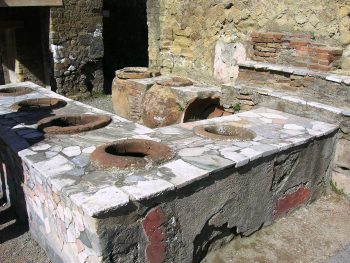Roman Dining Posted by jamie on Feb 22, 2019 in Intro to Latin Course, Roman culture
Note: This blog post is a companion to Unit X of our Introduction to Latin Vocabulary course. You can learn more about the course here.
Food is an essential part of all cultures, but when it comes to ancient cultures, food doesn’t tend to be one of the things that survive for very long. Luckily, we actually know a surprising amount about what, and how, the Romans ate. People have even managed to recreate Roman dishes today, like the one included below! In food, just as in all aspects of their lives, the Romans were in some ways very similar to us and in others vastly different. Let’s take a look at their food culture.
Triclinium
The dining room in a Roman mansion was called the triclinium, from the Greek words for three (tris) and lean (clinein). This was because Romans and Greeks didn’t sit down to eat as we do, but would instead lie down on couches. These couches were arranged in groups of three (hence the triclinium), in a horseshoe pattern, with the food on tables in the middle of the horseshoe. Diners would prop themselves on their elbows to reach the food.
Three people would lie on each couch—cozy!—and seating arrangements were based on status. The hosts would lie on the lectus imus (left-hand couch); the least important guests would lie on the lectus summus (right-hand couch); and the guests of honor would lie on the lectus medius (middle couch), with the most important guest on the far left side of the lectus medius, in the place called the locus consularis.
There were no utensils and no personal plates. Everything was eaten by hand, so slaves would provide bowls of water for washing-up before the meal.
Roman Cuisine
If you aren’t a fan of honey, salt, or vinegar, then I sincerely hope you never fall into a time warp back to ancient Rome! Those three ingredients were in almost every Roman dish. Salt was used to bring out flavors, just like today, but instead of sugar, honey was used to provide sweetness (sugar was only known as an Indian medicine during Roman times). These three ingredients were used in ways you might find unpleasant today—like cabbage cooked in a boiled honey-vinegar mix—but the Romans loved these flavors. (They were also big fans of garlic; one recipe for ancient pesto calls for 20 cloves of garlic. Personally, I’m into it.)
While we’re on the subject, I really can’t leave out their favorite seasoning, a sauce known as garum or liquamen. Liquamen was made by pouring heaps of salt over fish guts, then leaving the mixture out in the sun for days to rot. When it was good and stinky, the liquamen would be strained, bottled, and sold. The Romans couldn’t get enough of the stuff. And even though that description sounds really gross, liquamen was probably delicious. Many salty sauces today—Worcestershire sauce, soy sauce, Thai fish sauce—are made by letting the ingredients rot a little bit.
Most of what we know about cooking in ancient Rome comes from a cookbook called Apicius, containing hundreds of recipes, which was probably first written in the 1st century AD and then added to over the centuries. The recipes are very different in format from the ones we use today—there are almost no measurements, temperatures, or times, so modern chefs who recreate ancient dishes have to use a lot of guesswork.
Cena
A banquet (cena recta) was a major social event. Dozens, even hundreds of guests might be invited, and they would come wearing special, colorful dining clothes called cenatoria. Guards were posted to prevent gate-crashers (parasiti), who often managed to sneak in anyway.
Banquets would begin with the gustatio (appetizers), usually small savory foods like sausages, eggs, or honey-dipped rodents, and then continue on to the cena (main course).
This could be almost anything, and the richer you were the more dramatic you wanted your cena to be. A simple main course might involve chicken cooked in wine, or a pig’s stomach cooked with nuts and vegetables. A really extravagant host might serve his guests flamingo tongue or ostrich stew.
After the cena was taken away, slaves would bring in the secunda mensa (dessert). Just like today, the secunda mensa was sweet: dishes like honey-cakes or apricots in honey-milk, and fruits like figs and apples. Because meals almost always started with eggs and ended with apples, the Romans had a saying: ab ovo usque ad malum, or ‘from the egg to the apple’, which meant ‘from beginning to end.’ You would probably find a lot of Roman dishes strange, but the desserts still taste pretty good. Try this recipe for dates with honey and pine nuts—it’s delicious!
At the end of the night, guests would be allowed to take home whatever they could carry in a mappa (napkin). Providing enough food that there would be leftovers was an important part of Roman hospitality.
Wine
Romans drank almost exclusively wine with meals. They knew about other alcoholic beverages, like beer and cider, but virtually never drank them. Wine was an essential part of what it meant to be Roman.
However, they wouldn’t drink wine merum (straight-up). If they were in a sweet mood, they would mix honey into the wine, for a drink they called mulsum. At most other times they added a certain amount of water to the wine, and at a party there was a person whose job it was to decide how much water to add. This person was called the arbiter bibendi, and they had a serious responsibility. Too little water, and the wine would be sour and unpleasant; too much water, and nobody would get drunk. The arbiter bibendi had to read the mood of the party, and mix accordingly.
Daily Dining
Most people who lived in Ancient Rome didn’t have triclinia, or slaves to cook for and serve them. In fact, in the cities, many middle-class and poor people lived in insulae (apartment buildings), where starting a fire for cooking risked burning the whole building down. These people would usually eat on the street, at stands or small restaurants called tabernae or popinae, where food was cheap and hot. The Roman government also provided flour to the lower classes cheaply or for free, but those who received the flour had to take it to a bakery and pay to have it made into bread. Lower-class people who wanted a taste of the good life would have to sneak into rich-guy parties as parasiti.
Yes, Roman banquets were (for rich people) sociable, luxurious, probably pretty smelly affairs. How do they sound to you? Would you want to eat dinner sprawled on a couch with your family? Would you eat the flamingo tongue? Would you sprinkle some garum on it?
Glossary of Latin Words and Phrases
ab ovo usque ad malum – ‘from egg to apple’, a phrase meaning ‘from the beginning to the end’
arbiter bibendi – the ‘drinking judge’, whose job it was to decide how much water to add to the wine
cena – dinner/main course
cena recta – banquet
cenatoria – dining-out clothes, usually colorful
garum – see liquamen
gustatio – appetizers
insula – apartment building
lectus imus – left-hand host couch
lectus medius – middle, guest-of-honor couch
lectus summus – right-hand, less-important-guest couch
liquamen – a salty sauce made of rotten fish, used by the Romans in or on almost every savory dish
locus consularis – the most privileged spot in the triclinium
mappa – napkin
merum – unmixed or straight-up wine
mulsum – wine with honey
parasitus – a gate-crasher or moocher
popina – a small restaurant or snack stand serving street food
secunda mensa – dessert
taberna – see popina
triclinium – Roman dining room, with three reclining couches arranged in a horseshoe pattern

Build vocabulary, practice pronunciation, and more with Transparent Language Online. Available anytime, anywhere, on any device.






